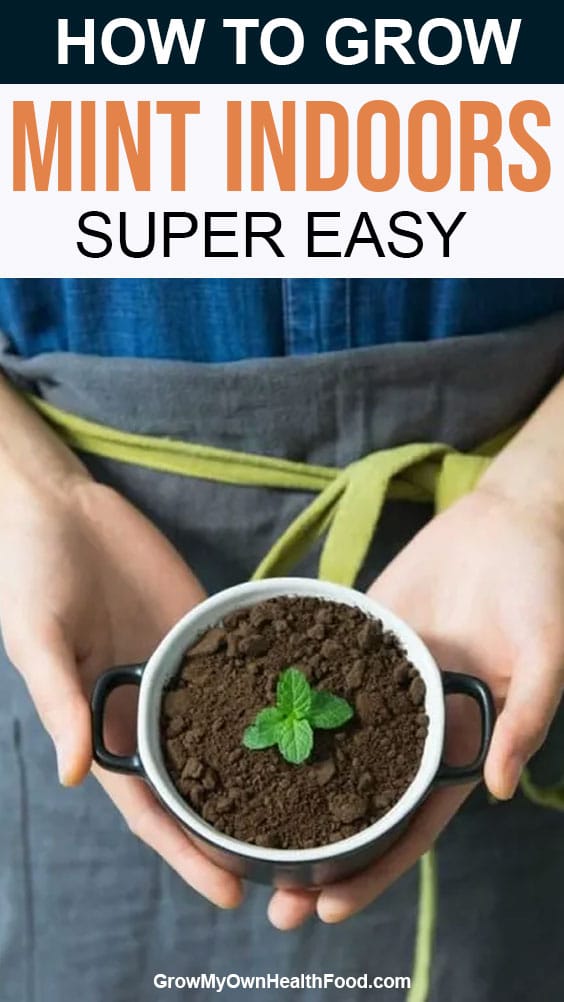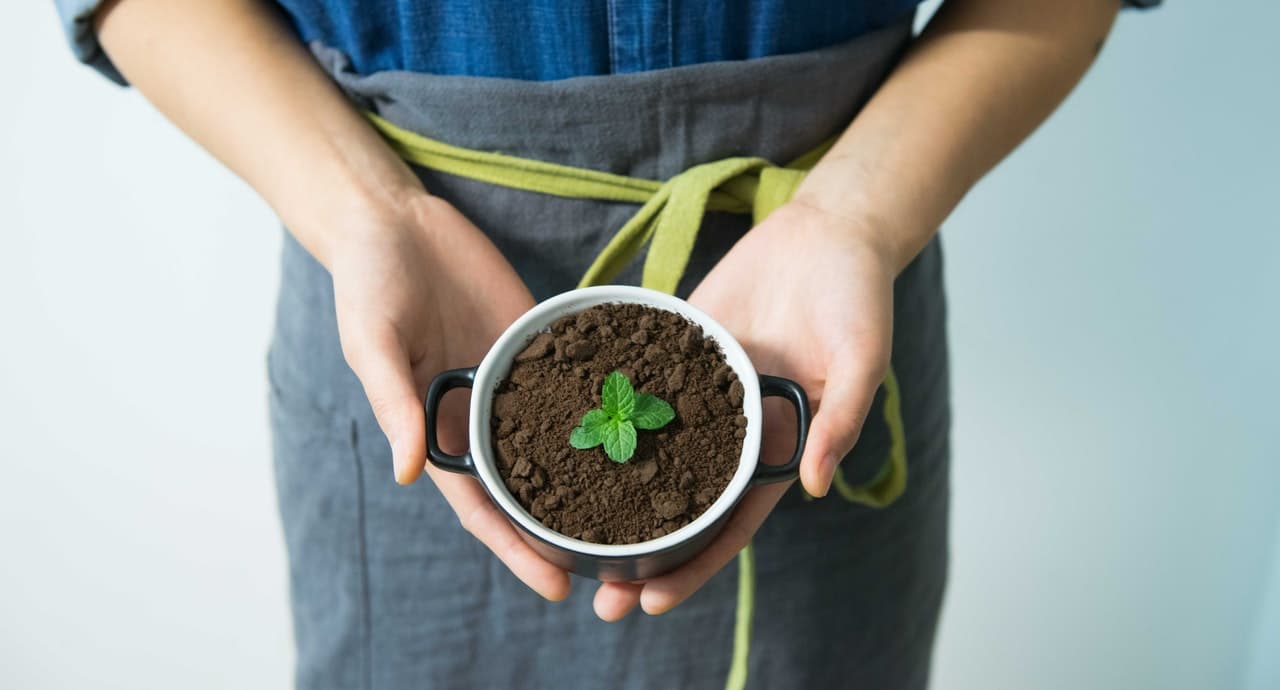Mint is a fantastic, aromatic herb that is also super easy to grow indoors. Fresh mint smells incredible growing inside; it creates a relaxing, soothing atmosphere. It’s also wonderful having mint right at your fingertips for a quick hot tea, hot chocolate, or for making a much needed mojito.
Did you know there are over 600 varieties of mint? Yes, there are so many more than the classic peppermint or spearmint. Of course, simple peppermint is good, but these are a few others that we love. If you can’t decide on just one (and why would you want to!), this collection of mints solves that problem.
- LOOKING FOR THE BEST MINT VARIETY PACK? - We have compiled the 5 different variety of mint seeds in one nice package with bonus plant markers
- HIGH GERMINATION HERB SEEDS - Test at 95% germination rates, you wont be disappointed with the growth of these seeds. Included is also some growing and planting tips and tricks.
- QUALITY HEIRLOOM & Non-GMO MINT SEEDS - These seeds are sourced in the USA and are great for growing indoors or outdoor mint plants.
- PERFECT FOR YOUR GARDEN, COOKING, or TEAS - Mint goes well with so many different foods and is also great as an herbal tea
- 100% GROWTH GUARANTEED & PRODUCT OF USA - Our garden seeds are sustainable sourced in the USA. Have confidence about our quality and 100% satisfaction guarantee. If by any reason they dont work out contact us for a new one. These seeds can work with aerogarden pods and other hydroponic systems.
Prices pulled from the Amazon Product Advertising API on:
Product prices and availability are accurate as of the date/time indicated and are subject to change. Any price and availability information displayed on [relevant Amazon Site(s), as applicable] at the time of purchase will apply to the purchase of this product.
Top 5 Favorite Mint Varieties
Chocolate Mint –
A mint that smells like chocolate, what could be better? The smell is light, the taste is perfect, and it is amazing in hot cocoa.
Orange Mint –
The fragrant scents of citrus and lavender combine together to make this mint extra special. It adds zing to a freshly prepared salad, is excellent in jellies, and turns lemonade into an exotic treat.
Apple Mint –
A mildly fruity, subtle fragrance makes this mint variety unique and distinguished. It is especially enjoyable brewed in a hot tea, and works wonderfully to melt the world’s worries away.
Pineapple Mint –
When you yearn for the tropics, pineapple mint delivers. Add this sweet, fragrant exotic-smelling mint to fruit salads or salsas to make the flavor pop.
Ginger Mint –
The delicious fruity ginger scent of this mint is delightful. It is excellent crushed and stirred into iced tea or lemonade, especially on a hot summer day.
How To Grow Mint Indoors
The easiest way to grow mint is to get a cutting from a friend or buy a plant from a local nursery. Mint seeds are sometimes difficult to germinate; they take 2-4 weeks to sprout. Mint plants are perennial and will thrive for many years indoors. Once you have one plant, it is easy to start other with cuttings from the original.
Grow Mint From Seeds
- INDOOR & OUTDOOR: These rustic-style flowerpots can be used to embellish your front door, living room console, or kitchen windows
- PLANT ANYTHING: Use your planter to nurture decorative plants and flowers, or to grow vegetables and herbs for your spring salad
- THREE SIZES: Set includes one 18in, one 15in, and one 11.5in wide bucket flowerpot; all made with stain-resistant, finished wood
- STURDY DESIGN: Built with durable, finished wood that looks classy and also keeps a strong hold while resisting stains from too much water
- DRAINAGE HOLES: Allow excess water to run out, promoting healthy soil and ensuring strong root growth; OVERALL DIMENSIONS: Large Barrel Dimensions: 18(Dia) x 14(H), Medium Barrel: 15(Dia) x 11.5(H), Small Barrel: 11.5(Dia) x 10(H); Weight: 13 l
Prices pulled from the Amazon Product Advertising API on:
Product prices and availability are accurate as of the date/time indicated and are subject to change. Any price and availability information displayed on [relevant Amazon Site(s), as applicable] at the time of purchase will apply to the purchase of this product.
- Fill a nice potting container with a good organic potting soil mix.
- Wet the soil well.
- Spread a few seeds over the prepared area, then cover them with 1/4” more soil.
- Put the pot in a warm location.
- Lightly spray the soil with water every day, so it is moist but not soggy.
- When the seeds sprout, move the mint plant to a warm, sunny windowsill where it will receive lots of indirect sunlight (east-facing is best).
- Thin the seedlings once they reach a few inches tall, so there are 4-6” between each plant.
- Water when the top of the soil feels dry, usually once or twice a week.
Grow Mint From Cuttings
- Cut a 4-6” branch off the stem of the mint plant right below the node.
- Remove the leaves from the bottom few inches so that none will be in the water.
- Put the stem in a clear glass or jar of water.
- Place the glass on a sunny windowsill.
- Every 3-4 days, change the water.
- Watch the stem grow roots, and when they reach 2-3”, transplant them to a good potting soil.
Grow Mint In Water, Without Soil
- Hydroponic Circulation System: Comes with an independent water pump, forms a water circulation system, increasing the oxygen. Plants growing in the nutrient water faster than soil. You have total control over the weather all year round.
- High-Performance Grow Lights: The 24-Watt LED lights of the hydroponics growing system simulate the sunlight spectrum, promoting veggies photosynthesis in any weather. the indoor gardening with veggies can be placed in the kitchen, bedroom or office. The indoor garden kit is an educational gift for children, helping them to observe the process of growth. Parents and grandparents will also love year-round fresh veggies.
- 3 Smart Modes for Different Growth Stages: NORMAL MODE: 14h-on-and-10h-off-cycle, with red & blue & white LED lights, suitable for germination, bloom, viewing stage. GROW MODE: 16h-on-and-8h-off-cycle, with red & white LED lights, for germination and viewing stage. ENJOY MODE: 12h-on-and-12h-off-cycle, with 50% red & white LED lights, good for germination, bloom, viewing stage. Lights will be less noticeable in this mode.
- 2 Water Pump Circulation Modes: In normal mode, the water pump works for 30 mins and pauses for 30 mins. Switch the water pump to sleep mode by long-pressing the “PUMP SWITCH” for 5 seconds. The water pump will turn off for 12 hours and will then return to the normal cycle. You can enjoy a deep sleep in the same room as your home garden.
- Height-Adjustable Garden Kit: The height of the lighting part of the hydroponics growing system can be adjusted for veggies at different growth stages, helping veggies absorb energy from LED lights and promoting growth. And you can simultaneously grow as many as 7 plants up to 14.57 inches with the 7 included po
Prices pulled from the Amazon Product Advertising API on:
Product prices and availability are accurate as of the date/time indicated and are subject to change. Any price and availability information displayed on [relevant Amazon Site(s), as applicable] at the time of purchase will apply to the purchase of this product.
- Follow the instructions for growing mint from cuttings.
- When the roots develop, transfer the plant to a hydroponic system like this self-watering one. Or, for a creative centerpiece, consider this fish tank hydroponic garden combination.
- Continue changing the water every 3-4 days to replenish nutrients, and follow the instructions of the hydroponic system for adding grow fertilizers.
- As the plant grows, prune the top leaves off and use them in cooking or teas.
- Mint plants won’t grow forever in just water, but they do thrive for quite awhile. It’s best to transplant them to soil if you want them to live for years.
Mint Aromatherapy Uses
Mint is used to boost energy, stimulate circulation, soothe tension and stress, and alleviate muscle fatigue. Using fresh mint to refresh the mind and soul is as easy as pinching off a few leaves and holding them to your nose. Alternately, the mint leaves are lovely and still full of fragrance dried and used to create your own teabags. These make a great gift for stressed-out friends and family, too!
- Tea bag is single-use, disposable tea infuser for steeping high-quality loose leaf tea or herbs
- Steep tea with a more robust flavor without the hassle or mess of conventional straining
- Food nylon will not taint the flavor of brewed tea
- Steeping all types of tea, including black tea, oolong tea, green tea, chai, chamomile and other herbal tea too
- The bag we provided are empty, after put into tea, then heat sealed the diagonal, final it will be triang
Prices pulled from the Amazon Product Advertising API on:
Product prices and availability are accurate as of the date/time indicated and are subject to change. Any price and availability information displayed on [relevant Amazon Site(s), as applicable] at the time of purchase will apply to the purchase of this product.
Mint Culinary Uses
This versatile herb has many applications. It’s most commonly used to make tea (hot and cold), ice cream, hot chocolate, sauces, salad dressings, and enhance plain water. Fresh mint leaves added to ice cube trays and frozen are perfect for adding a zingy pop to summertime drinks. Mint also combines fantastically with basil to create a pesto with extra flavor depth. Chocolate cake flavored with and decorated with fresh mint leaves is utterly divine.
It’s the ideal time to learn how to grow mint indoors, as well as how to start growing all types of herbs indoors. As the days grow longer and we seek out extra comforts, it’s amazing to have fresh mint and other herbs on hand for re-energizing aromatherapy. An indoor herb garden is an uplifting and easy project for your home, with multiple benefits that last throughout the year.







